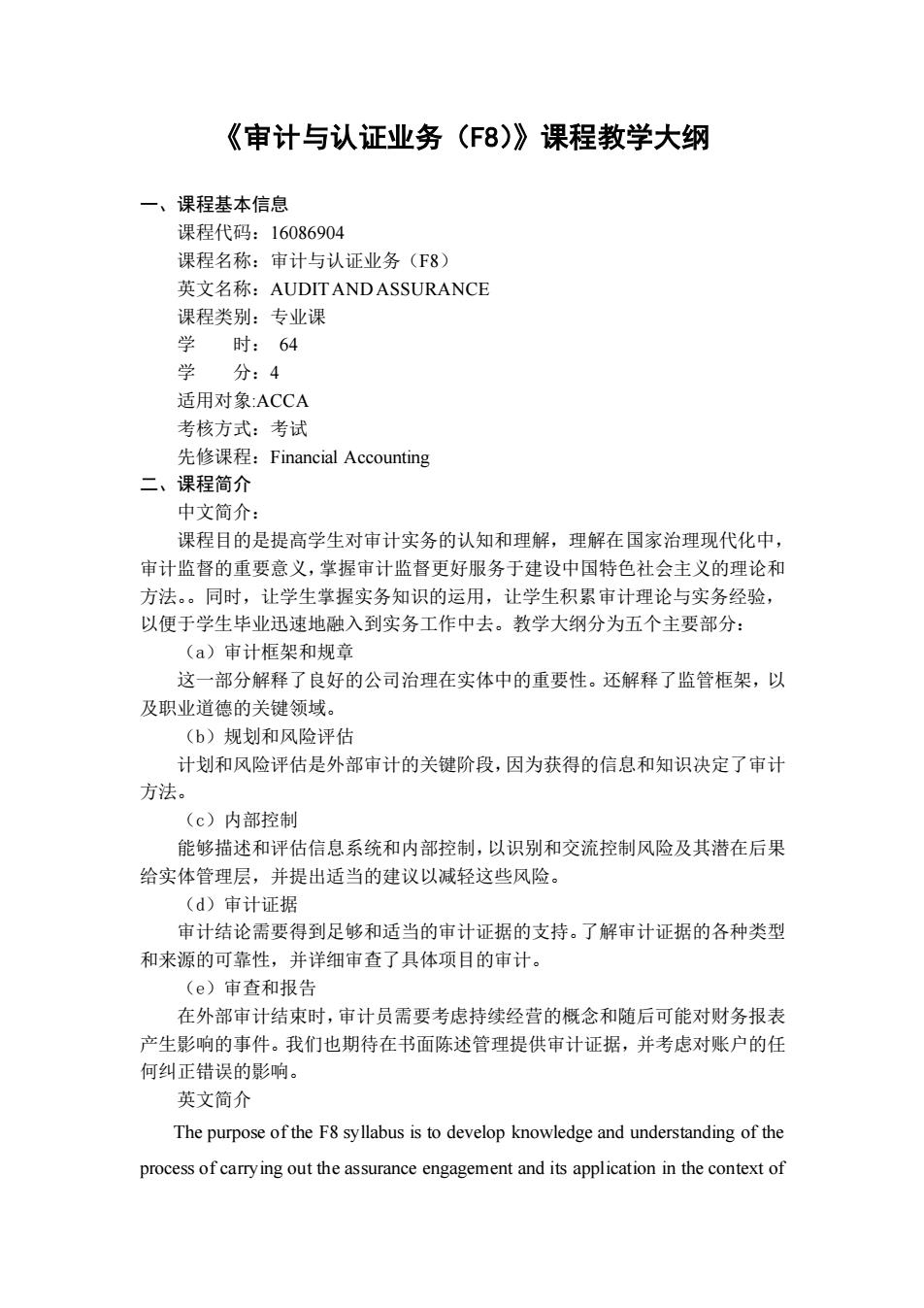
《审计与认证业务(F8)》课程教学大纲 一、课程基本信息 课程代码:16086904 课程名称:审计与认证业务(F8) 英文名称:AUDITANDASSURANCE 课程类别:专业课 学时:64 学 分:4 适用对象:ACCA 考核方式:考试 先修课程:Financial Accounting 二、课程简介 中文简介: 课程目的是提高学生对审计实务的认知和理解,理解在国家治理现代化中 审计监督的重要意义,掌握审计监督更好服务于建设中国特色社会主义的理论和 方法。同时,让学生掌握实务知识的运用,让学生积累审计理论与实务经验 以便于学生毕业讯速地融入到实务工作中去。教学大纲分为五个主要部分: (a)审计框架和规章 这一部分解释了良好的公司治理在实体中的重要性。还解释了监管框架,以 及职业道德的关键领域。 (b)规划和风险评估 计划和风哈评估是外部审计的关键阶段,因为获得的信息和知识决定了审计 方法 (c).内部控制 能够描述和评估信息系统和内部控制,以识别和交流控制风险及其潜在后果 给实体管理层,并提出适当的建议以减轻这些风险。 (d)审计证据 审计结论需要得到足够和适当的审计证据的支持。了解审计证据的各种类型 和来源的可靠性,并详细审查了具体项目的审计。 (e)审查和报告 在外部审计结束时,审计员需要考虑持续经营的概念和随后可能对财务报表 产生影响的事件。我们也期待在书面陈述管理提供审计证据,并考虑对账户的任 何纠正错误的影响, 英文简介 The purpose of the F8 syllabus is to develop knowledge and understanding of the process of carrying out the assurance engagement and its application in the context of
《审计与认证业务(F8)》课程教学大纲 一、课程基本信息 课程代码:16086904 课程名称:审计与认证业务(F8) 英文名称:AUDIT AND ASSURANCE 课程类别:专业课 学 时: 64 学 分:4 适用对象:ACCA 考核方式:考试 先修课程:Financial Accounting 二、课程简介 中文简介: 课程目的是提高学生对审计实务的认知和理解,理解在国家治理现代化中, 审计监督的重要意义,掌握审计监督更好服务于建设中国特色社会主义的理论和 方法。。同时,让学生掌握实务知识的运用,让学生积累审计理论与实务经验, 以便于学生毕业迅速地融入到实务工作中去。教学大纲分为五个主要部分: (a)审计框架和规章 这一部分解释了良好的公司治理在实体中的重要性。还解释了监管框架,以 及职业道德的关键领域。 (b)规划和风险评估 计划和风险评估是外部审计的关键阶段,因为获得的信息和知识决定了审计 方法。 (c)内部控制 能够描述和评估信息系统和内部控制,以识别和交流控制风险及其潜在后果 给实体管理层,并提出适当的建议以减轻这些风险。 (d)审计证据 审计结论需要得到足够和适当的审计证据的支持。了解审计证据的各种类型 和来源的可靠性,并详细审查了具体项目的审计。 (e)审查和报告 在外部审计结束时,审计员需要考虑持续经营的概念和随后可能对财务报表 产生影响的事件。我们也期待在书面陈述管理提供审计证据,并考虑对账户的任 何纠正错误的影响。 英文简介 The purpose of the F8 syllabus is to develop knowledge and understanding of the process of carrying out the assurance engagement and its application in the context of
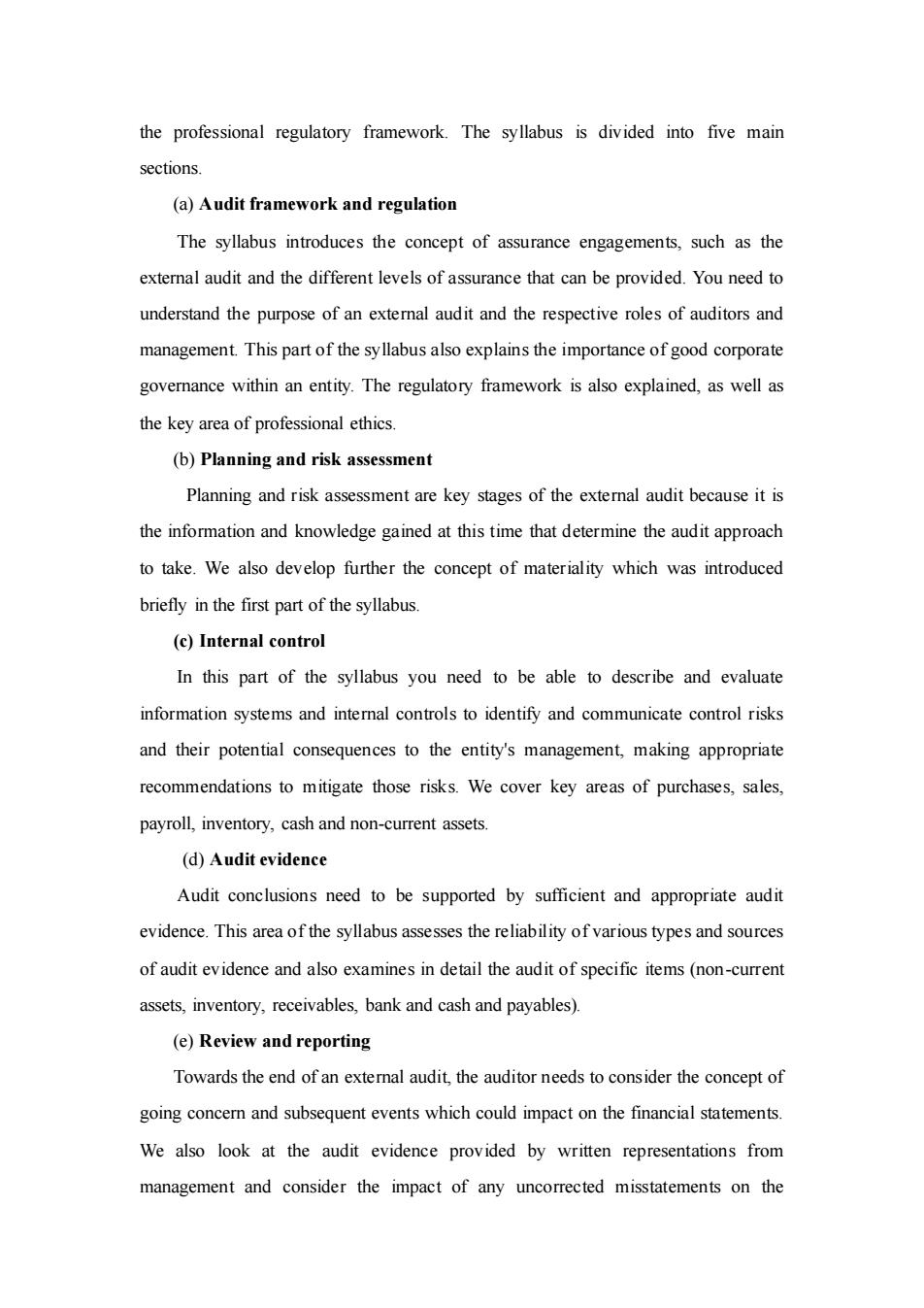
the professional regulatory framework.The syllabus is divided into five main sections. (a)Audit framework and regulation The syllabus introduces the concept of assurance engagements,such as the exteral audit and the different levels of assurance that can be provided.You need to understand the purpose of an extemal audit and the respective roles of auditors and management.This part of the syllabus also explains the importance of good corporate govemance within an entity.The regulatory framework is also explained,as well as the key area of professional ethics. (b)Planning and risk assessment Planning and risk assessment are key stages of the extemal audit because it is the information and knowledge gained at this time that determine the audit approach to take.We also develop further the concept of materiality which was introduced briefly in the first part of the syllabus. (c)Internal control In this part of the syllabus you need to be able to describe and evaluate information systems and interal controls to identify and communicate control risks and their potential consequences to the entity's management.making appropriate recommendations to mitigate those risks.We cover key areas of purchases,sales, payroll,inventory,cash and non-current assets. (d)Audit evidence Audit conclusions need to be supported by sufficient and appropriate audit evidence.This area of the syllabus assesses the reliability of various types and sources of audit evidence and also examines in detail the audit of specific items(non-current assets,inventory,receivables,bank and cash and payables). (e)Review and reporting Towards the end of an exteral audit,the auditor needs to consider the concept of going concem and subsequent events which could impact on the financial statements. We also look at the audit evidence provided by written representations from management and consider the impact of any uncorrected misstatements on the
the professional regulatory framework. The syllabus is divided into five main sections. (a) Audit framework and regulation The syllabus introduces the concept of assurance engagements, such as the external audit and the different levels of assurance that can be provided. You need to understand the purpose of an external audit and the respective roles of auditors and management. This part of the syllabus also explains the importance of good corporate governance within an entity. The regulatory framework is also explained, as well as the key area of professional ethics. (b) Planning and risk assessment Planning and risk assessment are key stages of the external audit because it is the information and knowledge gained at this time that determine the audit approach to take. We also develop further the concept of materiality which was introduced briefly in the first part of the syllabus. (c) Internal control In this part of the syllabus you need to be able to describe and evaluate information systems and internal controls to identify and communicate control risks and their potential consequences to the entity's management, making appropriate recommendations to mitigate those risks. We cover key areas of purchases, sales, payroll, inventory, cash and non-current assets. (d) Audit evidence Audit conclusions need to be supported by sufficient and appropriate audit evidence. This area of the syllabus assesses the reliability of various types and sources of audit evidence and also examines in detail the audit of specific items (non-current assets, inventory, receivables, bank and cash and payables). (e) Review and reporting Towards the end of an external audit, the auditor needs to consider the concept of going concern and subsequent events which could impact on the financial statements. We also look at the audit evidence provided by written representations from management and consider the impact of any uncorrected misstatements on the
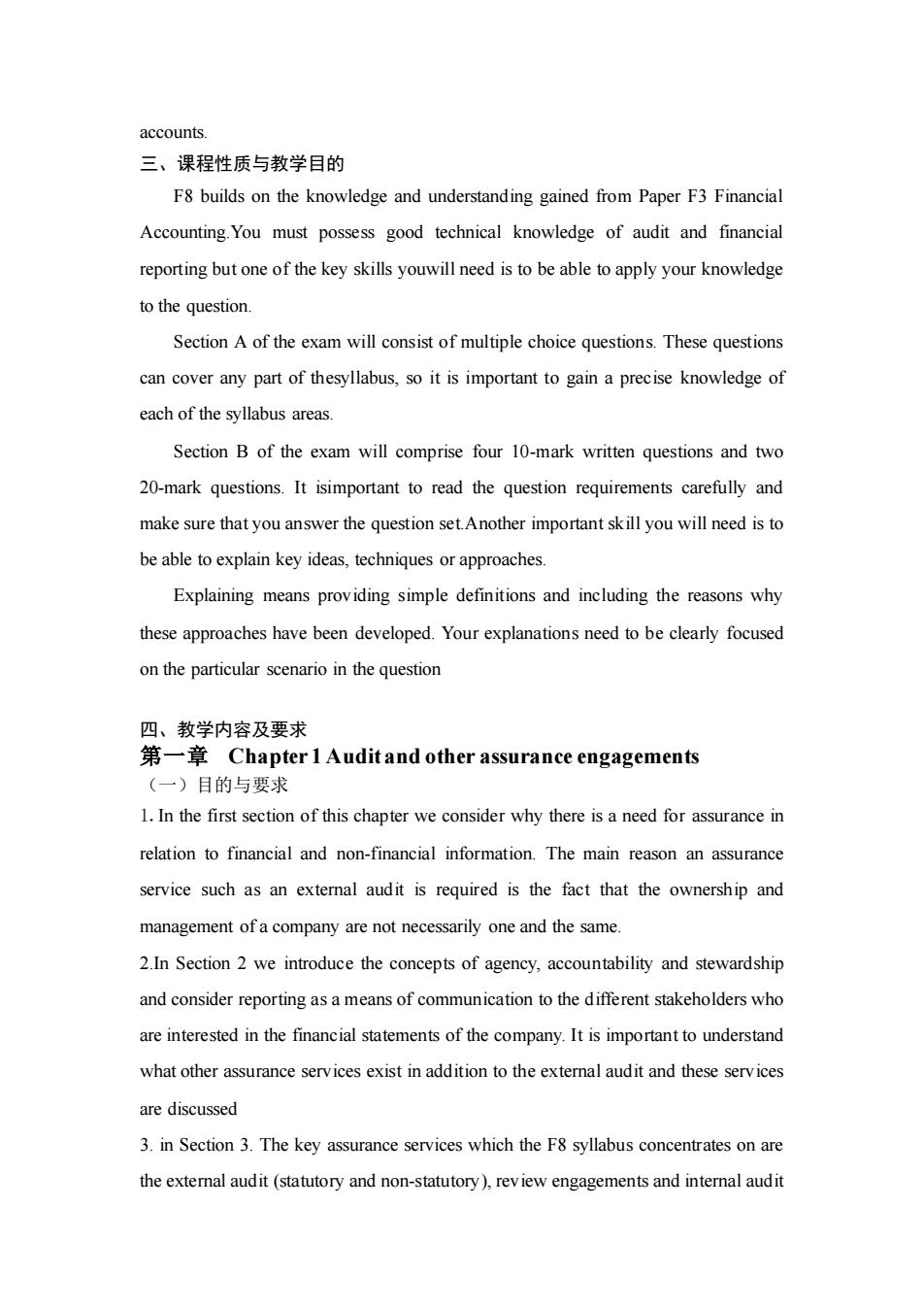
accounts. 三、课程性质与教学目的 F8 builds on the knowledge and understanding gained from Paper F3 Financial Accounting.You must possess good technical knowledge of audit and financial reporting but one of the key skills youwill need is to be able to apply your knowledge to the question. Section A of the exam will consist of multiple choice questions.These questions can cover any part of thesyllabus,so it is important to gain a precise knowledge of each of the syllabus areas Section B of the exam will comprise four 10-mark written questions and two 20-mark questions.It isimportant to read the question requirements carefully and make sure that you answer the question setAnother important skill you will need is to be able to explain key ideas,techniques or approaches Explaining means providing simple definitions and including the reasons why these approaches have been developed.Your explanations need to be clearly focused on the particular scenario in the question 四、教学内容及要求 第一章Chapter 1 Audit and other assurance engagements (一)目的与要求 1.In the first section of this chapter we consider why there is a need for assurance in relation to financial and non-financial information.The main reason an assurance service such as an extemal audit is required is the fact that the ownership and management of a company are not necessarily one and the same 2.In Section 2 we introduce the concepts of agency,accountability and stewardship and consider reporting as a means of communication to the different stakeholders who are interested in the financial statements of the company.It is importantto understand what other assurance services exist in addition to the extemal audit and these services are discussed 3.in Section 3.The key assurance services which the F8 syllabus concentrates on are the extemal audit(statutory and non-statutory).review engagements and intemal audit
accounts. 三、课程性质与教学目的 F8 builds on the knowledge and understanding gained from Paper F3 Financial Accounting.You must possess good technical knowledge of audit and financial reporting but one of the key skills youwill need is to be able to apply your knowledge to the question. Section A of the exam will consist of multiple choice questions. These questions can cover any part of thesyllabus, so it is important to gain a precise knowledge of each of the syllabus areas. Section B of the exam will comprise four 10-mark written questions and two 20-mark questions. It isimportant to read the question requirements carefully and make sure that you answer the question set.Another important skill you will need is to be able to explain key ideas, techniques or approaches. Explaining means providing simple definitions and including the reasons why these approaches have been developed. Your explanations need to be clearly focused on the particular scenario in the question 四、教学内容及要求 第一章 Chapter 1 Audit and other assurance engagements (一)目的与要求 1.In the first section of this chapter we consider why there is a need for assurance in relation to financial and non-financial information. The main reason an assurance service such as an external audit is required is the fact that the ownership and management of a company are not necessarily one and the same. 2.In Section 2 we introduce the concepts of agency, accountability and stewardship and consider reporting as a means of communication to the different stakeholders who are interested in the financial statements of the company. It is important to understand what other assurance services exist in addition to the external audit and these services are discussed 3. in Section 3. The key assurance services which the F8 syllabus concentrates on are the external audit (statutory and non-statutory), review engagements and internal audit
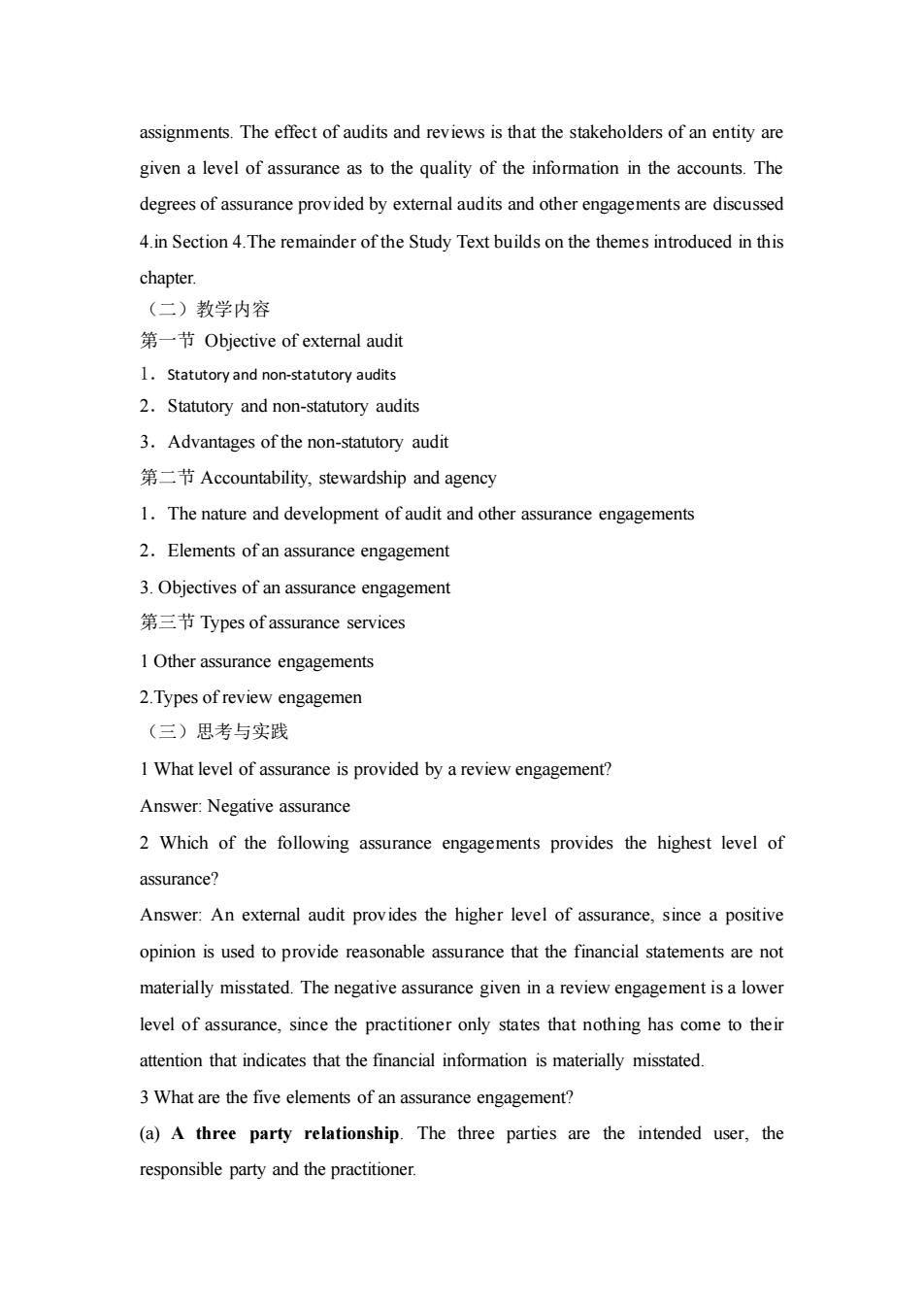
assignments.The effect of audits and reviews is that the stakeholders of an entity are given a level of assurance as to the quality of the information in the accounts.The degrees of assurance provided by external audits and other engagements are discussed 4.in Section 4.The remainder of the Study Text builds on the themes introduced in this chapter. (二)教学内容 第-节Objective of extemal audi 1.Statutory and non-statutory audits 2.Statutory and non-statutory audits 3.Advantages of the non-statutory audit 第二节Accountability,stewardship and agency 1.The nature and development of audit and other assurance engagements 2.Elements of an assurance engagement 3.Objectives of an assurance engagement 第三节Types of assurance services 1 Other assurance engagements 2.Types of review engagemen (三)思考与实践 1 What level of assurance is provided by a review engagement? Answer:Negative assurance 2 Which of the following assurance engagements provides the highest level of assurance? Answer:An extemal audit provides the higher level of assurance,since a positive opinion is used to provide reasonable assurance that the financial statements are not materially misstated.The negative assurance given in a review engagement is a lower level of assurance,since the practitioner only states that nothing has come to their attention that indicates that the financial information is materially misstated 3 What are the five elements of an assurance engagement? (a)A three party relationship.The three parties are the intended user,the responsible party and the practitioner
assignments. The effect of audits and reviews is that the stakeholders of an entity are given a level of assurance as to the quality of the information in the accounts. The degrees of assurance provided by external audits and other engagements are discussed 4.in Section 4.The remainder of the Study Text builds on the themes introduced in this chapter. (二)教学内容 第一节 Objective of external audit 1.Statutory and non-statutory audits 2.Statutory and non-statutory audits 3.Advantages of the non-statutory audit 第二节 Accountability, stewardship and agency 1.The nature and development of audit and other assurance engagements 2.Elements of an assurance engagement 3. Objectives of an assurance engagement 第三节 Types of assurance services 1 Other assurance engagements 2.Types of review engagemen (三)思考与实践 1 What level of assurance is provided by a review engagement? Answer: Negative assurance 2 Which of the following assurance engagements provides the highest level of assurance? Answer: An external audit provides the higher level of assurance, since a positive opinion is used to provide reasonable assurance that the financial statements are not materially misstated. The negative assurance given in a review engagement is a lower level of assurance, since the practitioner only states that nothing has come to their attention that indicates that the financial information is materially misstated. 3 What are the five elements of an assurance engagement? (a) A three party relationship. The three parties are the intended user, the responsible party and the practitioner
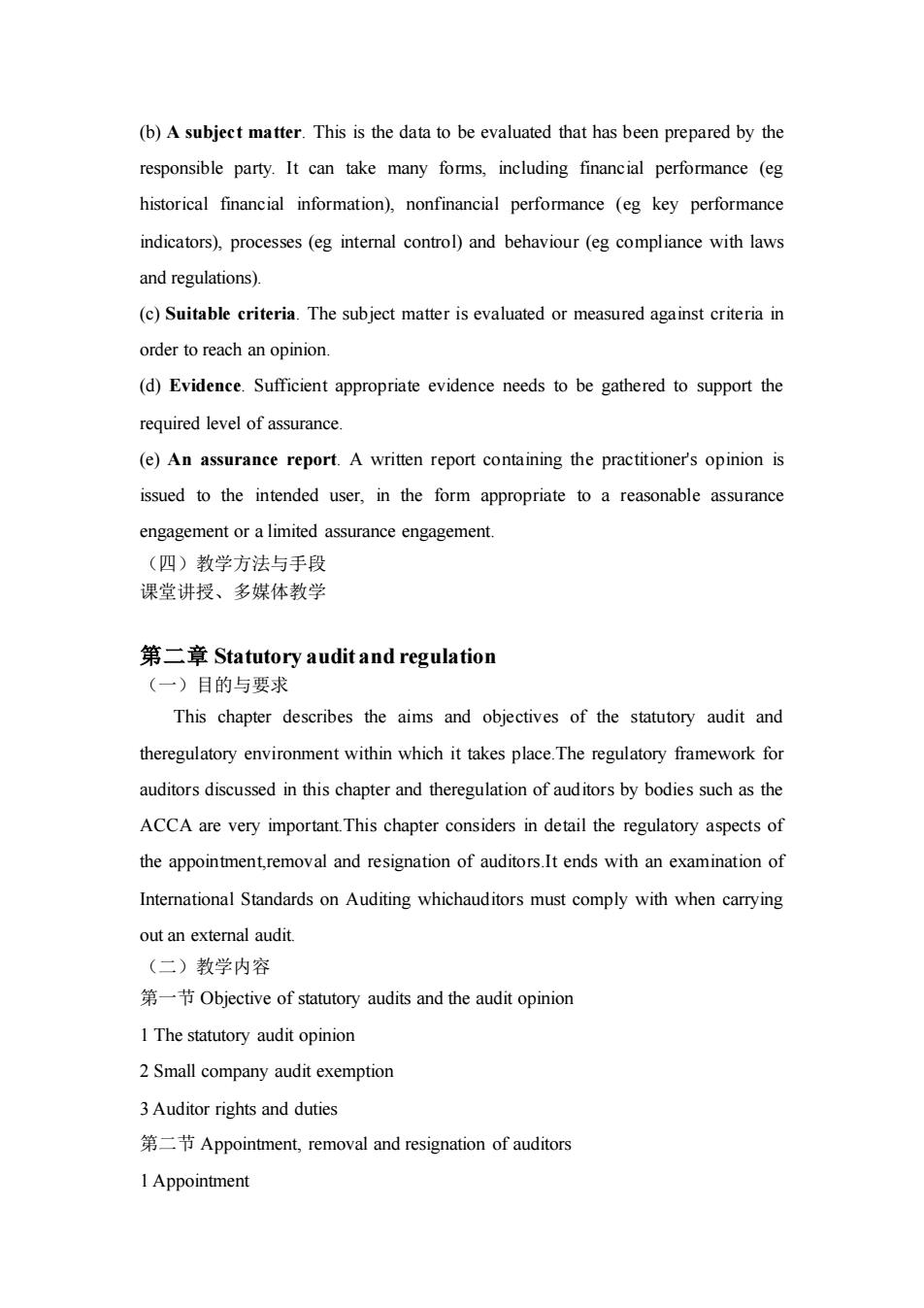
(b)A subject matter.This is the data to be evaluated that has been prepared by the responsible party.It can take many forms,including financial performance (eg historical financial information),nonfinancial performance (eg key performance indicators),processes(eg internal control)and behaviour (eg compliance with laws and regulations). (c)Suitable criteria.The subject matter is evaluated or measured against criteria in order to reach an opinion. (d)Evidence.Sufficient appropriate evidence needs to be gathered to support the required level of assurance (e)An assurance report.A written report containing the practitioner's opinion is issued to the intended user,in the form appropriate to a reasonable assurance engagement or a limited assurance engagement. (四)教学方法与手段 课堂讲授、多媒体教学 第二章Statutory audit and regulation (一)目的与要求 This chapter describes the aims and objectives of the statutory audit and theregulatory environment within which it takes place.The regulatory framework for auditors discussed in this chapter and theregulation of auditors by bodies such as the ACCA are very importantThis chapter considers in detail the regulatory aspects of the appointmentremoval and resignation of auditors.It ends with an examination of International Standards on Auditing whichauditors must comply with when carrying out an extemal audit. (二)教学内容 Objective of statutory audits and the audit opinion 1The statutory audit opinion 2Small company audit exemption 3Auditor rights and duties 第二节Appointment,.removal and resignation of auditors 1 Appointment
(b) A subject matter. This is the data to be evaluated that has been prepared by the responsible party. It can take many forms, including financial performance (eg historical financial information), nonfinancial performance (eg key performance indicators), processes (eg internal control) and behaviour (eg compliance with laws and regulations). (c) Suitable criteria. The subject matter is evaluated or measured against criteria in order to reach an opinion. (d) Evidence. Sufficient appropriate evidence needs to be gathered to support the required level of assurance. (e) An assurance report. A written report containing the practitioner's opinion is issued to the intended user, in the form appropriate to a reasonable assurance engagement or a limited assurance engagement. (四)教学方法与手段 课堂讲授、多媒体教学 第二章 Statutory audit and regulation (一)目的与要求 This chapter describes the aims and objectives of the statutory audit and theregulatory environment within which it takes place.The regulatory framework for auditors discussed in this chapter and theregulation of auditors by bodies such as the ACCA are very important.This chapter considers in detail the regulatory aspects of the appointment,removal and resignation of auditors.It ends with an examination of International Standards on Auditing whichauditors must comply with when carrying out an external audit. (二)教学内容 第一节 Objective of statutory audits and the audit opinion 1 The statutory audit opinion 2 Small company audit exemption 3 Auditor rights and duties 第二节 Appointment, removal and resignation of auditors 1 Appointment